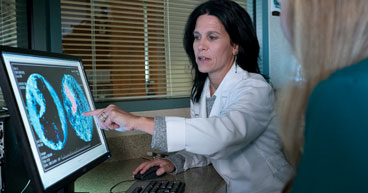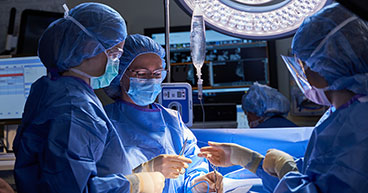
More than 108,000 American women will be diagnosed with a gynecologic cancer this year and nearly one-third will die from the diseases. Unfortunately, the numbers have been heading in the wrong direction in the past decade, with incidence rates increasing by about 1 percent a year in white women and up to 3 percent a year in women in other racial and ethnic groups. Additionally, the death rates from gynecologic cancers have risen by nearly 2 percent a year over the past 20 years.
While these numbers continue to grow, many of these gynecological cancers are treatable with positive outcomes with surgical intervention—specifically, robotic-assisted surgery. A 2015 survey of 408 women who underwent robotic surgery for gynecological cancers found that the majority were satisfied with the results.
“In this prospective study, general health, symptom burden and sexual function returned to or improved beyond baseline levels within 6 weeks of surgery,” the study concluded. “Overall, women were satisfied with their decision to undergo robotic surgery.”
However, there is an underserved population of high-risk women for whom surgery is not recommended or who are denied surgical options due to a higher risk of mortality. These women may have co-morbidities and/or be of an age that may impact the outcomes of their gynecologic oncology surgeries. These include women who:
- Are obese
- Older than 65
- Have co-morbidities, such as heart disease and diabetes
But with the right expertise, technology and experience, many of these women have a strong chance of experiencing a positive outcome from surgery and maintaining a good quality of life.
In this article we’ll examine the advantages robotic surgery may offer high-risk gynecologic cancer patients. Topics include:
- A multidisciplinary approach to robotic surgery
- Prioritizing preoperative and postoperative care
- A focus on anesthesia
- The importance of experience and expertise
- Weighing the risks versus benefits
If you’ve been diagnosed with a gynecologic cancer and are interested in getting a second opinion on your diagnosis or treatment options, call us or chat online with a member of our team.
A multidisciplinary approach to robotic surgery
Robotic-assisted surgery offers a minimally invasive approach to treating a variety of gynecologic cancers, including:
Robotic assisted therapy offers multiple potential benefits, including:
- Less pain, bleeding and scarring
- A lower risk of infection
- Shorter hospital stays
- Faster recovery times
Having performed 1,500 robotic surgeries, including many on high-risk gynecologic patients, I know that performing this type of procedure extends beyond the robotic tool and the surgeon operating it. It requires a highly specialized and multidisciplinary team approach that addresses all aspects of the intervention.
Prioritizing preoperative and postoperative care
When it comes to any surgery—robotic or otherwise—patient care extends well beyond the procedure itself. A collaborative and multidisciplinary effort is required to address a patient’s status before and after the surgery. Programs such as Enhanced Recovery After Surgery (ERAS) and the Advanced Surgical Recovery Program (ASURE) have been known to help patients reduce fatigue, complications and the need for narcotics in post-surgical care. These programs also are designed to help patients resume everyday activities more quickly.
Preoperatively, a patient’s care team may perform several assessments. Patients may have consultations with a variety of clinicians, including, but not limited to:
- Anesthesiologist
- Behavioral health counselor
- Nutritionist
- Respiratory or pulmonary specialist
- Pain management physician or physiatrist
- Physical therapist
Patients should feel fully informed about the preoperative and postoperative plans and feel empowered to ask questions and be involved in their care strategy, including plans to reduce the need for narcotics after the procedure.
Postoperatively, these same providers should collaborate, address new issues and adjust the care plan as needed. In addition to addressing a patient’s emotional status and pain levels, it is important to get the patient up and moving following surgery to help prevent complications. Under the care of a registered dietitian, a patient may benefit from reintroducing a regular diet as soon as the second or third day after surgery, as well as chewing gum immediately after surgery to help kickstart the digestive system.
A focus on anesthesia
When it comes to anesthesia and positioning for robotic surgery, there’s no room for error. Patients who have a high body mass index (BMI) or other health concerns may have compromised ventilation with anesthesia, especially since they must be in the Trendelenburg position, with the head tilted down about 30 percent with the pelvis up for robotic surgery.
The anesthesia team must be experienced and comfortable with:
- Establishing a good intra-abdominal ventilation system to put less pressure on the blood vessels and diaphragm
- Understanding how to safely position the patient to prevent a heart attack
- Putting less pressure on the blood vessels and the diaphragm
I prefer to use a special proprietary insufflation system that helps with airflow in the pneumoperitoneum during surgery. Proper air flow and ventilation keep conditions in the abdomen workable and may reduce the length of the procedure, which make things easier and safer for the anesthesiologist ventilating a patient with a higher BMI in the Trendelenburg position.
Lidocaine or ketamine infusions or other pain management methods such as local pain blocks may also be considered to help reduce the amount a pain a patient experiences post-operatively.
The importance of experience and expertise
Working with the high-risk gynecologic cancer patients requires experience. Women who are obese may have more complications and side effects from the surgery itself and from anesthesia. The surgeon needs to be comfortable working under these conditions and confident in their skills to help reduce the chance of reopening the patient.
It is important to keep in mind the high likelihood of a positive outcome for gynecologic cancer patients. I have completed successful robotic surgeries on many high-risk women who were over the age of 65, had multiple co-morbidities and with BMIs higher than 60 (30 or higher is considered obese), so I make sure to keep a positive outlook about their outcomes in each case and not let their high-risk status sway me.
To help cut down on pain, a local, long-acting pain block in the abdominal wall during surgery may also be considered. Most of my patients report minimal pain upon waking from surgery and typically go home taking only acetaminophen or ibuprofen when I introduce a pain block.
Weighing the risks versus benefits
While the high-risk gynecologic cancer patient population has a higher mortality rate, the benefits of robotic surgery and chance for a positive outcome should be weighed against risks. As a provider, I feel strongly in doing everything in my power to help patients achieve those outcomes.
Robotic surgery may be appropriate for many high-risk patients in treating gynecological cancers. However, the care should extend beyond the surgery itself, incorporating the right expertise and a dedicated team that addresses all aspects of a patient’s care.
If you’ve been diagnosed with a gynecologic cancer and are interested in getting a second opinion on your diagnosis or treatment options, call us or chat online with a member of our team.



